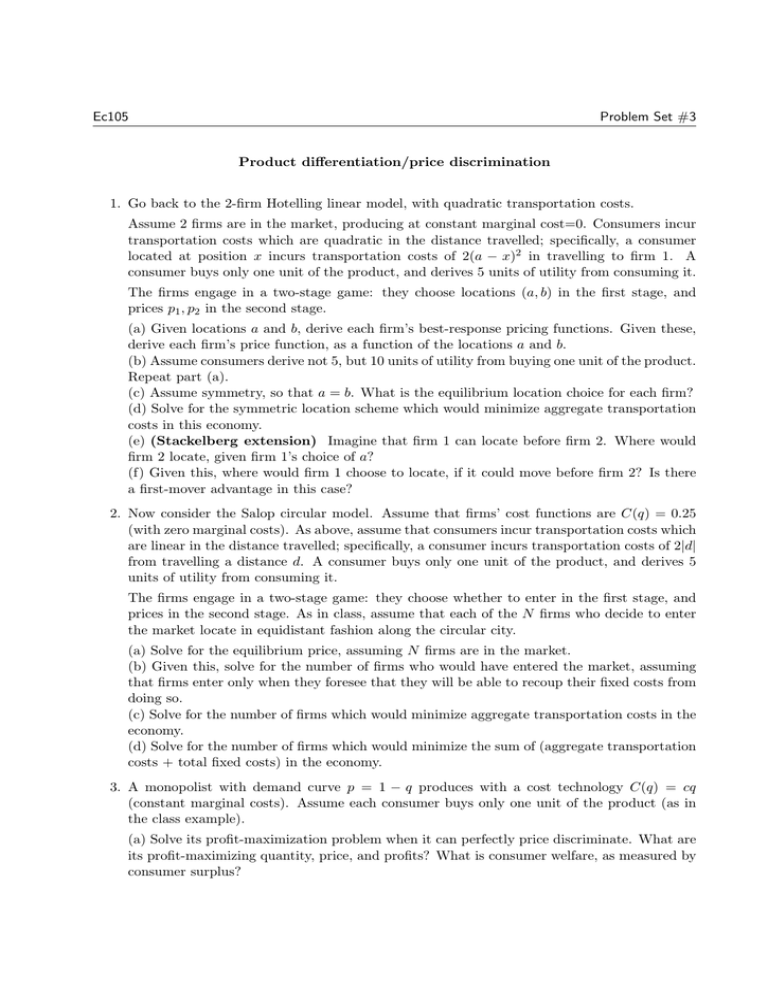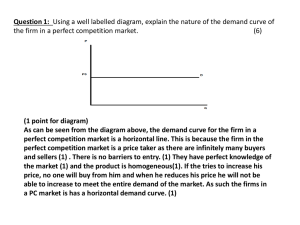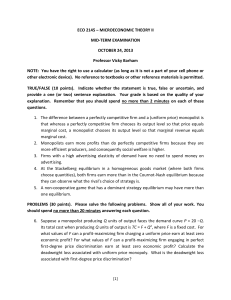Ec105 Problem Set #3 Product differentiation/price discrimination
advertisement

Ec105 Problem Set #3 Product differentiation/price discrimination 1. Go back to the 2-firm Hotelling linear model, with quadratic transportation costs. Assume 2 firms are in the market, producing at constant marginal cost=0. Consumers incur transportation costs which are quadratic in the distance travelled; specifically, a consumer located at position x incurs transportation costs of 2(a − x)2 in travelling to firm 1. A consumer buys only one unit of the product, and derives 5 units of utility from consuming it. The firms engage in a two-stage game: they choose locations (a, b) in the first stage, and prices p1 , p2 in the second stage. (a) Given locations a and b, derive each firm’s best-response pricing functions. Given these, derive each firm’s price function, as a function of the locations a and b. (b) Assume consumers derive not 5, but 10 units of utility from buying one unit of the product. Repeat part (a). (c) Assume symmetry, so that a = b. What is the equilibrium location choice for each firm? (d) Solve for the symmetric location scheme which would minimize aggregate transportation costs in this economy. (e) (Stackelberg extension) Imagine that firm 1 can locate before firm 2. Where would firm 2 locate, given firm 1’s choice of a? (f) Given this, where would firm 1 choose to locate, if it could move before firm 2? Is there a first-mover advantage in this case? 2. Now consider the Salop circular model. Assume that firms’ cost functions are C(q) = 0.25 (with zero marginal costs). As above, assume that consumers incur transportation costs which are linear in the distance travelled; specifically, a consumer incurs transportation costs of 2|d| from travelling a distance d. A consumer buys only one unit of the product, and derives 5 units of utility from consuming it. The firms engage in a two-stage game: they choose whether to enter in the first stage, and prices in the second stage. As in class, assume that each of the N firms who decide to enter the market locate in equidistant fashion along the circular city. (a) Solve for the equilibrium price, assuming N firms are in the market. (b) Given this, solve for the number of firms who would have entered the market, assuming that firms enter only when they foresee that they will be able to recoup their fixed costs from doing so. (c) Solve for the number of firms which would minimize aggregate transportation costs in the economy. (d) Solve for the number of firms which would minimize the sum of (aggregate transportation costs + total fixed costs) in the economy. 3. A monopolist with demand curve p = 1 − q produces with a cost technology C(q) = cq (constant marginal costs). Assume each consumer buys only one unit of the product (as in the class example). (a) Solve its profit-maximization problem when it can perfectly price discriminate. What are its profit-maximizing quantity, price, and profits? What is consumer welfare, as measured by consumer surplus? Ec105 Problem Set #3 (b) Solve its profit-maximization problem when it cannot price discriminate at all. What are its profit-maximizing quantity, price, and profits? What is consumer welfare? Compare these with the results in part (a). (c) Assume that although each consumer consumes only one unit of the product, she can buy multiple units of the product, and resell the units she doesn’t need at the purchase price. Solve the monopolist’s profit-maximization problem in this environment, when it can perfectly price-discriminate. What are its profit-maximizing quantity, price, and profits? What is consumer welfare? Compare these with the results in part (a). (d) Assume that each consumer can buy multiple units of the product, and can resell the units she doesn’t need at a price equal to 110% of the purchase price (i.e., a consumer will buy 3 units at $100, and resell two of them for $110 each). Solve the monopolist’s profitmaximization problem in this environment, when it can perfectly price-discriminate. What are its profit-maximizing quantity, price, and profits? What is consumer welfare? Compare these with the results in part (a). (e) Based on these results, what is one reason why a pair of Levis 501 jeans are priced at (roughly) $50 in North America, but $100 and upwards in Europe? Assume Levis jeans are produced in the US. 4. Assume that a monopoly supplier of a good makes sales to customers located in different regions of the country. The demand functions for the good in each region are q1 = 1 − p1 , and q2 = 0.5 − p2 , where 1 and 2 index the two regions. Assume that production costs are zero. (a) Assuming that the monopolist must charge a uniform price to the two regions, calculate the profit-maximizing uniform price and profits. What is consumer welfare, as measured by consumer surplus? (b) Assume that the monopolist can engage in 3rd-degree price discrimination. Calculate the profit-maximizing price and consumer welfare for each region. (c) Does 3rd-degree price discrimination increase or decrease consumer welfare, as measured by consumer surplus, in this case? (Think about) Which consumers gained, and which lost? 5. Assume that there are two consumers of raisins. Mr. Smith has a utility function uH (x) = 10 + x − x2 , while Mrs. Parker has a utility function uL (x) = 10 + x − 2x2 . Farmer Gordon, the monopoly producer of raisins, cannot distinguish between Mr. Smith and Mrs. Parker. But he can sell different sized bundles, and charge different prices for them. (a) What are the utility-maximizing levels of raisin consumption xP and xS for Mrs. Parker and Mr. Smith, respectively? (b) Supposing Farmer Gordon offers bundles of size xP and xS . What are the prices (pP , pS ) that he should charge so that (i) Mr. Smith consumes the xS -sized bundle at price pS and (ii) Mrs. Parker consumes the xP -sized bundle at price pP ?







